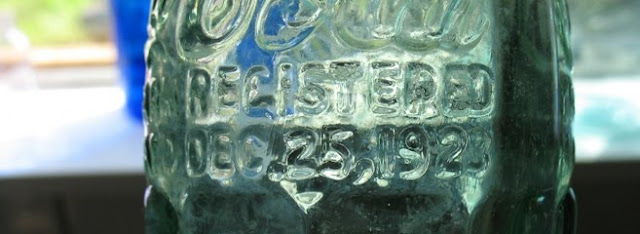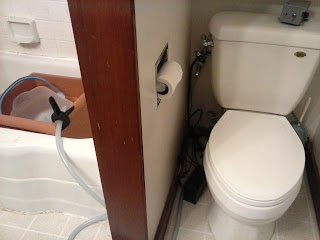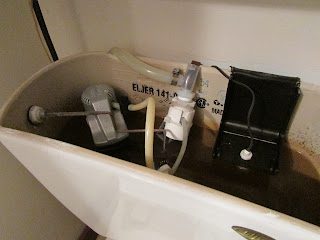We live in a home built originally around 1948, and some of the rooms have the original lath and plaster walls and ceilings. In an area like ours, with lots of shrink/swell to the soil and the occasional earthquake, that seems to be a recipe for cracks.
Ever since the Napa quake, a crack in our dining room ceiling had been slowly expanding. We were at a loss as to what to do about it. The attic is full of blown in insulation, and the dining room is in the center of the house and one side of it is actually a hall to the bedrooms and bathroom. We shifted the table out of the fall zone, put our electronics charging area into another room and dithered about what to do.
Finally, before dawn on the morning of July 4 we were wakened early by a loud CRASH. My poor husband jumped out of bed wondering if a car had hit the house, but I said "the ceiling fell down" Sure enough:
Since we had plans to go to a friends house for July 4th fun, and were leaving the next day for a week at the beach, we sprang into action and Ted did a quick repair job with plastic, duct tape and wooden battens.
This held till we got back from vacation, but then it was clear we could no longer postpone the inevitable, we had to make a decision and repair the ceiling. It was clear that with the unstable nature of the plaster, we would have to do a complete demo of the ceiling and take the plaster off the lath. Because our actic is full of blown in insulation, we did not want to also remove the lath, which is nailed directly to the roof joists. Plus it was very hot, we had to use the air conditioning while the ceiling was being repaired.
If we wanted to do the job ourselves materials would have to be something that could be handled by one pretty strong man and one not so strong woman. That meant nailing drywall to the ceiling was out of the question: way to heavy to handle for me, plus the surface it would be nailed to was totally uneven. We had tossed around the idea of wood for our cracked ceilings ever since we moved into the house 30 years ago, and that was the only possiblity that seemed like it would work. Looked around the internet and got some ideas and then it was off to the hardward store. We discovered some light weight 3 ply plywood made of some sort of tropical hardwood, and very thin and lightweight planking (4" by 5/16" by 8') in knotty pine or red cedar, made by Pine Ridge. We choose the pine.
If we wanted to do the job ourselves materials would have to be something that could be handled by one pretty strong man and one not so strong woman. That meant nailing drywall to the ceiling was out of the question: way to heavy to handle for me, plus the surface it would be nailed to was totally uneven. We had tossed around the idea of wood for our cracked ceilings ever since we moved into the house 30 years ago, and that was the only possiblity that seemed like it would work. Looked around the internet and got some ideas and then it was off to the hardward store. We discovered some light weight 3 ply plywood made of some sort of tropical hardwood, and very thin and lightweight planking (4" by 5/16" by 8') in knotty pine or red cedar, made by Pine Ridge. We choose the pine.
| Pine Ridge wood planking |
| Ceiling partially demoed, first 4 ft of plywood installed, bats hold plastic and plaster in place, tape holds plastic to plywood. |
We put three coats of polyurethane on the planks before installing them, using a wire shelf unit turned sideways as a drying rack. We did not stain the wood, wanting to keep the ceiling as light as possible and suspecting that the pine would darken with age anyway. Installing the planks was a two person job. The ceiling is 10 ft wide, but the joists are placed at 16 inch spacings, and the planks were 8 ft long. Each plank was first trial fitted, marked so it could be cut at the midpoint of a joist, and then taken outside to be cut with the electric saw. Then back inside, put adhesive on the back of the plank with a caulk gun, fit in place, I held it while Ted put on his safety gear, picked up the gun, I put on my safety gear and then we had to force out the warp as the board was nailed in place. We staggered the board lengths, but lengths were constrained by the placements of the joists. We had gotten 10% overage and we had just enough to finish the project. We caulked the edge of the room between the walls and lath before installing each plank. Once all the planks were up we filled the nail holes and put another coat of poly over the ceiling.
 |
| First ranks of wood ceiling planks installed over plywood, extra backing boards were put above plywood to stabilize area surrounding the LED cans. |
After much debate we repainted the room cottage rose white, aka beige. We bought narrow crown molding to conceal the rough edge between the walls and the ceiling. This we also installed with the nail gun, although one web site we looked at said not to. We tested the gun on a piece of scrap and there was no problem with splitting.
 |
| Finished wooden ceiling. |
The crown molding is slightly darker than the wood planks, but in real life it looks really great. An added advantage of our new ceiling is we replaced the dorky old center light fixture with LEDs. Downside of LEDs is they add static to the AM radio, which makes listening to the ballgame problematic unless we turn them off. We are very thrilled with the appearance of our new wooden ceiling. In retrospect, we should have made a point to put more shims along the edges of the ceilings to get the faces of the planks to all line up. There are varying amounts of space (tiny but noticeable if you look) between the top of the crown molding and each plank end.




